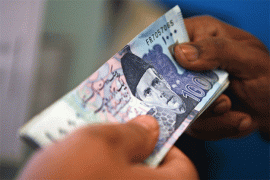
ISLAMABAD:
The State Bank of Pakistan (SBP) slashed key interest rate to a record low of 7% on Saturday, laying a foundation for implementing growth-oriented economic policies in the country.
“Given Pakistan’s current macroeconomic conditions, the SBP board of directors has decided to reduce the [interest] policy rate by 100 basis points (1%) to 7%, the lowest in 42 years,” announced SBP Governor Ashraf Mahmood Wathra following a meeting of the board. The new rate will be effective May 25.
This is a fourth cut in the key discount rate since November last year. The cut was prompted by a decline in inflation during the current fiscal year, which the central bank described as ‘broad-based’ in an official statement.
“All headline and underlying measures of inflation recorded deceleration,” the SBP said. The bank initially responded cautiously to the falling inflation rate.
The SBP also projected a subdued inflation rate in the coming months and said uncertainty about international oil prices and possible adjustment in domestic energy prices are the main risks to this inflation outlook.

The central bank lowered its key interest rate at a time when the federal government has decided to implement growth-oriented economic policies from the new fiscal year, beginning from July. Industrialists have long been demanding an interest rate below 8% to reduce their cost of business.
Finance Minister Ishaq Dar has already announced the government will announce certain measures for economic revival in the new budget, which will be unveiled on June 5.
The reduction in the policy rate will promote business activities in the country and reduce the input cost, the SBP governor said. However, he added that other factors, like the availability and prices of gas and electricity, could also affect industrial growth.
“Overcoming energy shortages and improving law and order conditions is expected to provide impetus in reviving investment and higher production,” the SBP said.
The bank gave credit for the current macroeconomic stability to domestic policies and favourable external developments.
Despite a significant reduction in interest rates, the monetary policy is not working its way through the economy, as the government remains the single largest borrower due to a steep decline in tax revenues, according to independent experts. This has left little credit for the private sector to borrow.
Wathra said that after previous cuts in the policy rates, two important developments took place: there was significant growth in long-term loans and trade financing quantum also jumped. He said the working capital requirements reduced due to a steep decline in commodity prices.
The SBP said the external current account position has further strengthened and the foreign currency reserves are expected to increase. Increase in foreign private inflows can strengthen this outlook and sustain stability in the foreign exchange market, it added.
The SBP board also reviewed the interest rate corridor – the band of minimum and maximum interbank rates – cutting the upper ceiling by 1% to 7% and fixing the lower cap at 5%, a reduction of half a percentage point. Wathra said the board decided to reduce the width of the corridor from 2.5% to 2% to ensure predictability in the money market.
Wathra also announced a new target rate, setting it at 0.5% lower than the key discount rate. Although the key interest rate is 7%, the SBP will target the 6.5% rate and will ensure that the repo rate remains close to the target rate, said the governor. He said these changes were consistent with the SBP plan announced in February and in line with best international practices.
“It is a good development and eventually the target rate will become the policy rate,” said former SBP governor Syed Salim Raza. He said the corridor’s ceiling above the target rate will have slightly penal cost for banks, as the SBP wants banks to fully utilise the available liquidity in the market before coming to it.
Published in The Express Tribune, May 24th, 2015.






















































COMMENTS (1)
Comments are moderated and generally will be posted if they are on-topic and not abusive.
For more information, please see our Comments FAQ